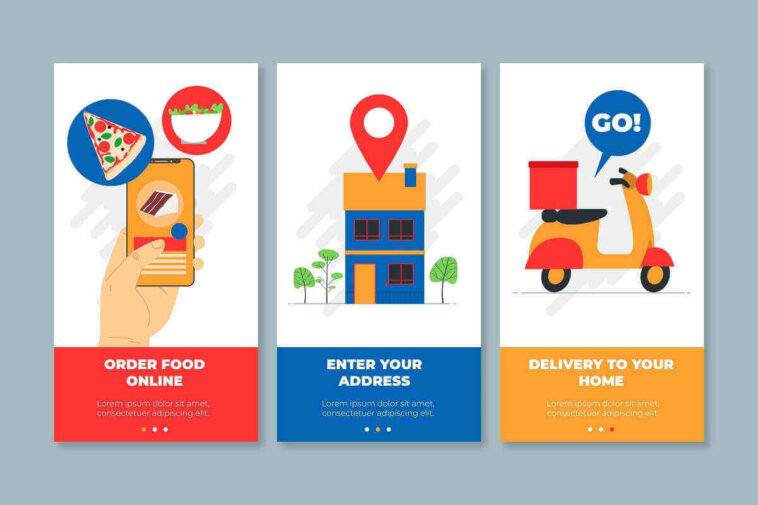COVID-19 has transformed the food delivery app industry and has become popular among a large number of people.
People actively use various food delivery apps, like DoorDash, GrubHub, or Uber Eats for convenient shopping experiences. These apps allow users to see the digital menu from the app, place an order, and get home delivery.
According to Statista, the market revenue of food delivery will reach nearly $466,472 million by 2026. Advanced features, like real-time notifications, search location-based restaurants, or multiple payment gateways make food delivery apps more prominent.
The food delivery industry’s growth has accelerated and become widely popular among business owners.
Read this blog till the end and find out more about food delivery app development, like food delivery app models, features, types, estimated costs, and more.
Type of On-Demand Food Delivery Models
-
The Aggregator Model:
The first on-demand food delivery model is the aggregator model, where restaurants and customers exist on a single platform.
Your targeted audience can easily place an order from the options available on the app. Later, the aggregator collects the order and passes it on to the respective restaurant. Afterward, the delivery boy of the restaurant delivers the order.
The model is divided into two sub-business models:-
- Integrated Model
- The Order and Delivery Model
-
The Logistic Support Model
Another on-demand food delivery model is the logistic support model, where business owners handle everything. From looking after the placed orders to home delivery, restaurant owners are responsible. This way, entrepreneurs can track the order list and the delivery.
The logistic support model allows businesses to interact directly with customers and check food quality. This model has a fixed cost that results in profit. Uber Eats or Postmates are some of the well-known examples of the logistic support model.
Popular Examples of Food Delivery Apps
-
DoorDash
One of the well-known examples of an on-demand food delivery app is DoorDash. It is an American-based online food ordering and delivery app with 56% of the market share. DoorDash is a logistic support model that means the food gets delivered from the restaurant with on-time delivery.
Some of the key features of DoorDash are dual rating features or personalized suggestions using AI technology.
-
GrubHub
Another popular food delivery app is GrubHub, founded in 2004. Users have to enter their favorite cuisine, and related restaurants will be listed. Feasible real-time order tracking or pre-ordering of the food are the top features of GrubHub.
-
Postmates
Postmates is an on-demand delivery app founded on 1st May 2011. The service is accessible on iOS and Android devices and offers pickup and delivery services. Users can easily customize their orders and make payments within the app.
-
UberEats
Uber Eats is a food delivery app founded in August 2014. The app allows customers to order food from local restaurants with a quick delivery service. You can even enjoy exciting offers or deals after taking the advanced membership. Customers can make payments from their uber accounts.
-
ChowNow
More than 14,000 restaurants and cafes have partnered with ChowNow, a cloud-based online meal delivery app. It was created in 2011. The app has a dedicated customer support team available around the clock and is secure.
Features of Food Delivery App
-
Real-Time Notifications
One of the prominent features of the food delivery app is the integration of push notifications that creates brand visibility and help you stay ahead of the curve.
You can keep your targeted audience engaged with your app by sending real-time notifications, like offers, discounts, upcoming sales, or any updates. As a result, you can quickly attract the user’s attention.
You must ensure that your food delivery app’s push notification feature adds value to your potential users. In short, manage real-time notifications in a way that will accelerate your business growth.
-
Real-Time Order Tracking
Another must-have feature you should integrate into your on-demand food delivery app is real-time order tracking. The integration of this feature expands user retention, boosts customer interaction, and, most importantly, improves business clarity.
Real-time order tracking also enhances customer satisfaction by building trust that might turn them into loyal ones. Both restaurant owners and customers can also track delivery agents.
-
Multiple Payment Options
Business owners must make a payment process productive and easy to access for users as it is a vital element for every business. You can incorporate multiple payment gateways as you don’t know which payment mode your customer uses.
There are multiple payment options that are popular in the market; for instance, PayPal, Stripe, Authorize.Net, Credit/Debit Cards, online banking, and more.
-
Easy Order Placement
The market of an on-demand food delivery app is skyrocketing as it delivers a smooth and convenient user experience. And this is possible only when you have created a simple & interactive user interface with easy order placement.
Create an easy-to-access digital menu for your users and let them place an order effortlessly. You must ensure that the menu is visible to every user, works properly, and has a fast loading speed. As a result, your business will receive a higher conversion rate.
-
Reviews & Ratings
Review & rating are another two must-have features for your on-demand food delivery app that will let you know how well your app is performing. It will help you understand your users’ preferences, upcoming demands, and more.
Most importantly, the feedback section can help you in achieving new users. It will also help you determine the app’s areas of improvement. In short, the review & rating feature will give you valuable insights into the food delivery app.
Top Monetization Models of Food Delivery App
-
Delivery Charges
The first monetization model of a food delivery app is delivery charges, where you can charge the money based on the distance covered or the percentage of the order amount.
-
Peak Hours
You can charge extra money from your customers during peak hours, like lunch or dinner. In this monetization model, business owners can limit the menu or location and charge extra to make the rest of the options available.
-
Advertising
Restaurants can advertise at extra charges and have their presence visible in the featured list to attract more customers by using this technique.
-
Commission Percentage
Another monetization strategy is commission percentage, where food delivery app owners partner with top-rated restaurants and earn extra money.
What Is the Cost of Developing an On-Demand Food Delivery App?
The cost of developing a food delivery app is not definite, and it varies from numerous factors. For instance, an app-building platform, features & functionalities, UI/UX design, app hosting & security, testing, and post-delivery maintenance & support.
The main cost-affecting factor of an on-demand food delivery app is the model you choose from the aggregator or logistic support model.
Get a no-obligation consultation from us for more details.
Conclusion
Make the most of this chance, as the food delivery app has taken off since the outbreak. To put it another way, the growing popularity of food delivery apps proves that this is a trend that won’t go away anytime soon.
So, hire a food delivery app development company, turn your app idea into reality, and generate significant revenue.
All the best!









GIPHY App Key not set. Please check settings